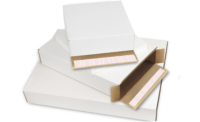Since its inception in the 1990s, ecommerce has been steadily increasing in popularity and is now an integral part of everyday life. Consumers have the ability to order practically any item that is delivered to their doorstep within a matter of hours or days. According to the U.S. Census Bureau, 2019, ecommerce sales are estimated to have reached an estimated $600-plus billion in 2019, increasing 14.9% from the previous year. With the recent COVID-19 global pandemic, our dependency on ecommerce has never been more significant. Having goods delivered to our doorsteps is not only a matter of convenience but a key contributor to our survival.
This surge of interest and dependence on this shopping platform has led to an increased focus on the importance of packaging. In many instances, the package that arrives on the doorstep is a consumer’s first interaction with a brand, and customer expectations are high. Many customers want packaging to be attractive, environmentally friendly and, perhaps most importantly, the contents inside are pristine. In this new normal, the role of an ecommerce strategy has never been more significant. How can companies put their best foot forward when engaging with their customers to routinely meet, or exceed, expectations?
Materials Matter
For many, the unboxing experience is an integral part of the overall purchasing process. The demand for attractive, personalized packaging is paramount and often can be a key factor in determining if a customer will repeatedly engage with a brand. Thus, companies must consider a multitude of variables when deciding upon their packaging strategy. One of the most important initial decisions any company must make is choosing materials that provide the most value to meet their packaging needs. There are a variety of material options to choose from when designing ecommerce packaging and each comes with its own pros and cons. Traditional cardboard boxes, for example, are one of the most common ecommerce packages. Thick layers of corrugated cardboard provide extra protection, but can also be costly and inefficient if sized incorrectly. Major shipping companies such as UPS, FedEx and the United States Postal Service price parcels based on dimensional weight, also known as DIM weight, which measures the amount of space a package takes up in relation to its weight.
In contrast to rigid packaging, flexible packaging is often more cost effective, but less protective and limited in size. Flexible packaging often contains clothing, pharmaceuticals and less fragile materials. With the introduction of digital printing, flexible packaging can now easily be personalized for the consumer. For the brand, this is an opportunity to reinforce the brand promise, promotional materials or even discounts. Both rigid and flexible packaging have an important role to play in ecommerce. They often are placed together for the greatest protection, and these materials have grown to include craft paper, pillows, molded pulp and more. What is imperative, however, is to keep an open mind when it comes to sourcing the right materials for your packaging needs and make smart decisions for your company and your customer.
Packaging Design Makes a Difference
Choosing the right material is integral to developing a durable package, but it doesn’t stop there; packaging design is just as important. Experienced packaging designers can help brands develop the right packaging to fit their needs. Amazon recently implemented the Amazon Packaging Support and Supplier Network, also known as APASS. This certification is designed to ensure the durability of packages that come from Amazon manufacturers and vendors. These packages are subject to a series of tests — including shock, compression, vibration and extreme temperatures tests — and the impact is evaluated by packaging experts. For brands and companies looking to sell on Amazon, it is important to find companies that not only administer these tests and certification, but can provide design consultation if the packages do not meet APASS standards. And smart packaging design can have a clear and positive impact on the bottom line.
While protecting the contents inside is a priority, designers also have to consider the attractiveness of the package that ends up on consumers’ doors. For many companies, such as direct-to-consumer brands and online retailers, packaging is one of the only opportunities to make a good impression on a customer. This reverts back to the importance of the unboxing experience. Unboxing experiences can end up on social media, drawing interest from friends and followers that result in word-of-mouth lead generation and new customers.
Environmental Concerns and Sustainable Materials
According to a 2019 Accenture survey, more than 80% of consumers feel it is “important or extremely important” for companies to design sustainable products. For brands and packaging companies alike, this presents the opportunity to invest in sustainable business practices and products that consumers value. Luckily, there are many options to use alternative, sustainable materials for ecommerce packaging. For example, fiber-based flexible packaging, such as craft paper, protects a package’s contents while also being curbside recyclable.
While using alternative materials in packaging is one way to protect the environment, sustainable transportation practices is another component. New technology reduces the required contents needed to contain and secure a shipping load, so manufacturers can use a thinner plastic on properly stacked and loaded pallets to reduce landfill waste when discarded. This process is called “downgauging” and is another way that manufacturers can prove their commitment to sustainability to consumers. For brands with sustainability in mind, packaging engineers can optimize the design to take up less space in transit, which maximizes space and reduces costs while protecting the earth.
To be certain, there is much to consider when developing a comprehensive and smart strategy. At first blush, the packaging materials and options can seem overwhelming. However, if you keep your customer needs top-of-mind and are willing to explore traditional and non-traditional options for materials and design, there is a tremendous opportunity to make a meaningful impact with your consumer and forge a strong relationship on behalf of your brand. The challenges of ecommerce can be tough to navigate, but with an experienced packaging partner, the opportunities and solutions are even more plentiful.






